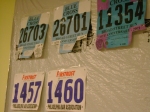At Educon 2.2 last weekend, the most unexpected, justly-poetic meta-moment was Shelly Blake-Pock‘s delivery of an impromptu mini-lesson on the etymology of “curriculum” in Sylvia Martinez‘s session on tinkering.
The Latin root “currere” means “to run,” and a course is a “race.” Even as the larger discussion was interrogating the need for and very idea of curriculum, Shelly pointed out how our understanding of these concepts is literally rooted in and shaped by the language we use. Curriculum as a path to be run suggests linearity, an intentional, mapped progression from starting point to end point, a channel, a route not be deviated from. Narrowness. Course as race suggests a contest: urgency, striving, speed. For the improvisers and tinkerers-at-heart in the room, it was a bracing reminder that our ideas and assumptions, even as we try to shift and remake and tinker with them, are made of ancient stuff.
But the best part was the live-action visual pun. Shelly was standing in front of this Room 208 posterboard:
This all raises the skinny specters of linearity [1] and determinism. Of tracks and ruts, of blue highways, of tangents and detours, of roads more or less (and more-or-less) traveled. Of courses run, and running to or from curriculum. Of mistakes and misdirections, deviations and course corrections, course changes and marked-up maps, sextants thrown overboard and land sighted.
Sylvia’s session was built around the notion of bricolage—playful experimentation, conversation with materials at hand, hands-on improv, fondness for the found, passion, tinkering with intent, what-have-you with what-you-have—as an alternate lens on knowledge construction. It’s remix culture in full flower, and it stands in direct counterpoint to traditional analytical problem-solving. Given generous amounts of space, time, at-hand materials, and low or no evaluation pressure, learners will figure things out and make meaning.
Is “curriculum” a restrictive construct that inhibits natural passion-based learning, a lockstep model demanding rigid adherence?
Or do the constructed boundaries of a curriculum serve as a guide-path for learning, a constraint [2] that, by focusing attention, sparks a creative response?
In other words, does curriculum keep us on track, or keep us from the constructive, creative process of getting lost?
[1] More on this later.
[2] More on this later, too, if I don’t get creatively constrained. [2a]
[2a] For example, footnotes like this one can be a creative constraint. DFW famously turned the dry lakebed of the footnote into a funhouse mirror of expansiveness.

